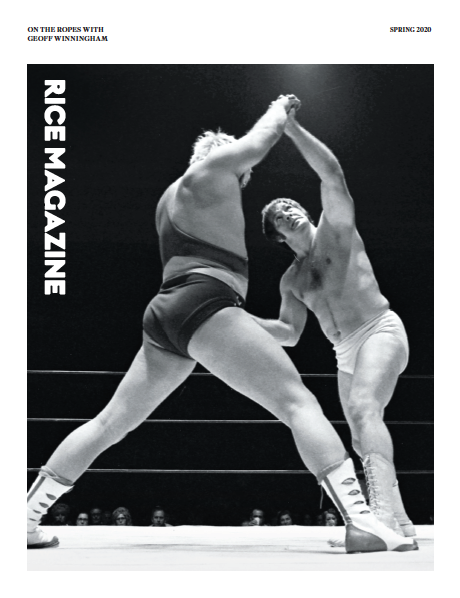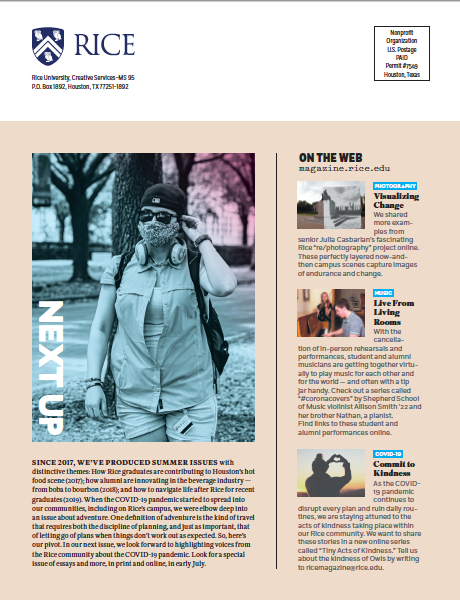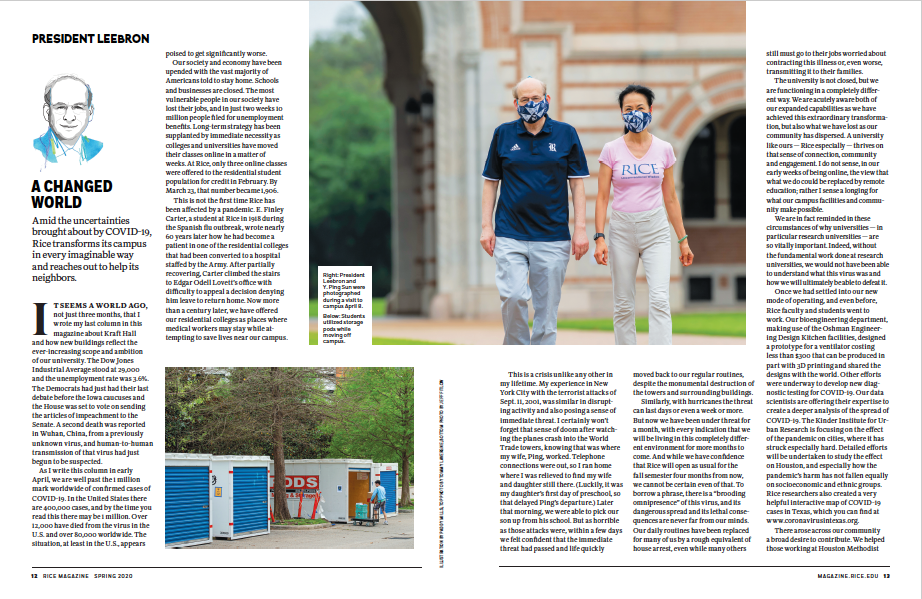

SURVEY SAYS
Complete In a Council for Advancement and Support of Education (CASE) survey we sent in 2018 to a wide variety of Rice Magazine readers, we learned that 78 percent of all respondents prefer reading the magazine in print (although our growing online magazine presence is gaining an audience alongside our print issue, too). Even 67 percent of alumni who graduated since 2000 indicated that they prefer to read the magazine in print. These results track with national CASE survey results. We expected that our alumni, for the most part, love receiving the magazine, but what surprised us was the degree to which they rely on it for information about their alma mater. For our oldest graduates (those who graduated in the 1950s, 1960s, and 1970s), the magazine is their No. 1 source of information about Rice. That holds true for graduates who earned degrees in the 1980s and 1990s. (The second most common source for information about their alma mater is emails.)
The Role of Print in a Crisis
In challenging times, a print periodical may be out of sync with breaking news — and therein lies the possibility for strengthening and deepening our connection with readers.
By Lynn Gosnell
When the first campus email alert about novel coronavirus arrived on Jan. 23, the threat seemed remote and abstract. Soon enough, new campus alerts and policies tracking “an evolving public health issue” began cascading into our inboxes. A month later, on Feb. 29, we learned of a possible case — eventually confirmed — of the virus on Rice’s campus. A rapid response by Rice administration prevented additional spread on campus — but it was scary. Just before spring break in mid-March, classes and labs were canceled so students and faculty could prepare for the possibility of remote instruction. Rice’s Dean of Undergraduates Bridget Gorman sent a heartfelt message to students telling them that, for their safety, as many students as possible should go ahead and return home for the rest of the semester.
“I know this news must be jarring to read,” she wrote, “and the days ahead will undoubtedly feel uncertain and stressful.” By late March, Rice’s faculty and staff had all “returned home” — hauling desktops, laptops, and even office chairs to makeshift workspaces, tethered to colleagues via our new lifelines, Slack and Zoom. Virtual gatherings and online outreach became the norm for institutional communication. Everything we took for granted as part of our educational mission — classes, athletics, events, beloved traditions (including our famous Beer Bike) — had been upended, postponed, or canceled entirely.
As we’re seeing play out on multiple fronts today, our quarterly, biannual, or even bi-monthly print magazines can’t keep pace with breaking news — but that’s not a bad thing. Our print magazines provide an opportunity for a slower, more sustained conversation about how our institutions are navigating a crisis of immeasurable complexity.
In “normal” times, our print edition, Rice Magazine, travels each quarter to the homes of 60,000 readers — including all alumni, parents of undergraduates, community leaders, and donors — where it hangs out on the coffee table for weeks, even months, on end. (We know this from survey data.) This traveling emissary plays a singular role in connecting our institution’s far-flung audiences back to their alma mater through stories that track, expand, and deepen a familiar cycle of academic news.
With news about COVID-19 moving at warp speed by midsemester, our small magazine team began to grapple with the question before us. How would we address the coronavirus in our working issue? And how could we not? We planned to go to press in mid-April, our print delivery timed for a festive commencement weekend that soon would be canceled as well. What would readers of our print magazine expect? Should we toss all the work-inprogress and start over?
Here was our pivot. We adopted an approach to our spring issue that would make room for both pandemic- and non-pandemic-related stories, taking full advantage of our print issue’s ability to make home visits. We aimed to build a Table of Contents that we hoped readers would find informative, interesting, and maybe a little bit unexpected. (The Rice motto is, after all, “unconventional wisdom.”) To do this, we made the following decisions:
- We moved forward as planned with substantial stories about research, teaching, creative achievements, and student life that we’d worked to produce over the previous few months.
- We kept two features, including one on a 1971 documentary project about Houston’s colorful pro-wrestling scene, titled “Friday Night in the Coliseum” (our cover story). Photographer and faculty member Geoff Winningham ’65 provided the black-and-white imagery of a bygone era.
- We subbed out a third feature, replacing it with an extended essay on the state of Rice in the early days of the pandemic. Our surveys have also told us that the column written by Rice President David Leebron is one of the top-read departments in the magazine. So, we asked him to expand his first-person column, and he agreed. His 1,500-word essay deftly and candidly summarizes Rice’s initial, rapid steps taken in response to the pandemic. These include moving hundreds of classes online in a matter of weeks, providing housing for healthcare workers in the residential colleges, and prototyping a $300 emergency ventilator. More importantly, President Leebron’s essay supplied both historical context and empathy. The ability of a print publication to deliver perspective on breaking news was never on better display.
- We canceled our planned summer issue’s theme on adventure and began planning an issue of essays on life in the pandemic. We “advertised” our plan in both the editor’s note and on the back cover in a space where we regularly tease the next issue’s content. This issue will have a completely different look and feel from our “standard” issues.
This improvisational approach situates COVID-19’s deep disruptions in the bigger picture of our university’s common life. The way I think of it now is that the printed spring issue mimics the dizzying changes in the wake of the virus’ impact on our campus. We went to press in late April and received our specially delivered office copies the week before Rice held its first-ever “virtual commencement,” a thoughtful and ultimately moving event that featured the reading of every degree recipient’s name over the course of three different ceremonies.
Our themed summer issue includes a collection of beautifully illustrated original essays about “life in the pandemic.” We hope these stories by Rice alumni, staff, and faculty, along with artwork created by students and faculty, will be a complement to the ongoing news cycle about COVID-19. At the least, it’s a perfect bound gift to readers and an invitation to an ongoing conversation about our institution’s mission, challenges, and unfolding history. In a crisis, that’s important. (As I write this, Texas is experiencing a surge of hospitalizations and new cases. Right now, Rice is planning on welcoming students back to a changed campus in August.)
I keep thinking about Dean Gorman’s observation that “the days ahead will undoubtedly feel uncertain and stressful.” That was the plain-spoken truth then — and is more so now, in early June, when our country and world is convulsed by yet another horrific crime that reveals the pain and trauma of racism in our history and society. Our campus community, though scattered, is alive with passionate words and actions in response to the killing of former Houston resident George Floyd.
In a letter to the campus community about Rice’s response to the tragedy and ensuing national outrage and protests, President Leebron wrote, in part, “We must work to build an inclusive environment, one that respects and values people from different backgrounds. We must take part in efforts to reduce the deadly discrimination and racism that is an unstaunched wound in our national fabric.” We’ll improvise yet again to address this national crisis in our print magazine, sharing stories of Rice’s commitment to building a better university and engaging our community in another vital conversation.
Lynn Gosnell is editor of Rice Magazine at Rice University. Connect via gosnell@pagesthemagazine.com.


